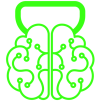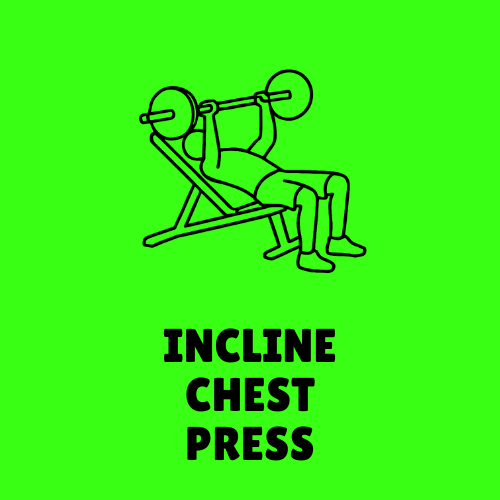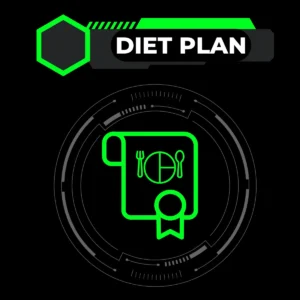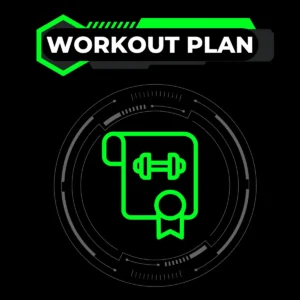Primary Muscle Groups Worked
The incline chest press primarily targets the pectoralis major, specifically the clavicular head, which forms the upper portion of the chest. This muscle group plays a key role in pushing and pressing movements, giving the chest a fuller, more balanced look. Regularly incorporating the incline chest press ensures the upper chest is as developed as the mid and lower sections, creating a more aesthetic physique.
Secondary Muscle Groups Engaged
While the upper chest is the star of the show, several secondary muscles come into play during the incline chest press, including:
1. Anterior Deltoids (Shoulders)
- The anterior deltoids assist in the upward pressing motion, particularly at the start of the movement.
2. Triceps Brachii
- The triceps help extend the elbows during the pressing phase, supporting the chest muscles throughout the lift.
3. Stabilizer Muscles
- Smaller muscles, such as the serratus anterior and rotator cuff, work to stabilize the shoulder joint and maintain proper alignment during the lift.
Instructions for Performing the Incline Chest Press
To get the most out of the incline chest press, proper form and technique are essential. Here’s a step-by-step guide to performing this exercise correctly:
Step 1: Adjust the Bench
- Set the bench to an incline angle between 30 and 45 degrees.
- Avoid angles steeper than 45 degrees, as this will engage the shoulders more than the chest.
- Ensure the bench is stable and positioned securely.
Step 2: Choose Your Equipment
- Use either a barbell, dumbbells, or an incline press machine depending on your preference and skill level.
- Start with a manageable weight to maintain control and proper form.
Step 3: Position Yourself
- Sit on the bench and lean back so that your back is pressed firmly against the pad.
- Place your feet flat on the ground for stability.
- Hold the barbell or dumbbells with your hands slightly wider than shoulder-width apart. For dumbbells, your palms should face forward.
Step 4: Perform the Lift
- Starting Position: Begin with the barbell or dumbbells at chest height. Keep your elbows at a 45-degree angle relative to your torso.
- Press Upward: Push the weight upward in a controlled manner until your arms are fully extended but not locked out.
- Lower the Weight: Slowly lower the barbell or dumbbells back to the starting position, keeping tension on the chest muscles.
Tips for Proper Form
- Keep your back neutral and avoid arching excessively.
- Maintain a steady pace throughout the movement to prevent using momentum.
- Breathe out as you press the weight up and inhale as you lower it.
Benefits of the Incline Chest Press
The incline chest press is a cornerstone exercise for upper body development. Here are some of its key benefits:
1. Targets the Upper Chest
Unlike the flat bench press, the incline chest press emphasizes the upper portion of the pectoralis major, helping to create a fuller and more defined chest.
2. Enhances Shoulder Strength
This exercise engages the anterior deltoids, improving shoulder strength and stability. Strong shoulders also reduce the risk of injury during other upper-body exercises.
3. Builds Tricep Strength
While the chest is the primary muscle worked, the incline chest press also heavily activates the triceps, contributing to overall arm strength and size.
4. Improves Posture
By strengthening the upper chest and shoulders, this exercise helps correct rounded shoulders and poor posture, especially for those who sit for long hours.
5. Boosts Aesthetic Appeal
A well-developed upper chest enhances the overall symmetry of the upper body, contributing to a more athletic and sculpted look.
Variations of the Incline Chest Press
Changing up your routine with variations of the incline chest press can help target different muscle fibers and prevent plateaus. Here are some popular variations:
Equipment variations
1. Dumbbell Incline Chest Press
- Using dumbbells allows for a greater range of motion and helps correct muscle imbalances.
- Perform the movement as described in the instructions but with a dumbbell in each hand.
2. Barbell Incline Chest Press
- A barbell allows you to lift heavier weights and focus on building raw strength.
- Keep your grip slightly wider than shoulder-width to fully engage the chest.
3. Incline Machine Press
- Machines provide a more controlled movement, making them ideal for beginners or
4. Resistance Band Incline Chest Press
- For a portable and joint-friendly option, resistance bands can be used to mimic the incline chest press motion.
- Secure the band at a low anchor point, sit on an incline bench, and press the band handles upward, focusing on controlled movement.
5. Unilateral Incline Dumbbell Press
- This variation involves pressing with one arm at a time.
- It improves core stability and ensures equal strength development on both sides of the chest.
- Perform the standard incline chest press movement but alternate arms or do one side at a time.
Angle variations
The closer the bench angle is to 45 degrees, the more pressure is applied to the shoulders. Conversely, the closer the angle is to 30 degrees, the more pressure is focused on the upper chest.
Common Mistakes to Avoid
Even seasoned lifters can make mistakes that hinder results or lead to injury. Here are the most common errors to watch for when performing the incline chest press:
1. Arching the Lower Back
- Many lifters arch their lower back excessively to lift heavier weights. This shifts the focus from the upper chest to other muscle groups and increases the risk of injury.
- Solution: Keep your core engaged and your back pressed firmly against the bench.
2. Incorrect Grip Width
- A grip that’s too wide or too narrow can place undue stress on the shoulders and wrists.
- Solution: Use a grip that is slightly wider than shoulder-width to optimize chest activation.
3. Using Too Much Weight
- Ego lifting often leads to poor form and incomplete range of motion, which reduces effectiveness.
- Solution: Start with a weight that allows you to maintain control and proper technique throughout the set.
4. Failing to Use a Full Range of Motion
- Shortening the range of motion minimizes chest activation and makes the exercise less effective.
- Solution: Lower the weight fully to your chest (or slightly above for dumbbells) and extend your arms fully at the top.
5. Overlooking Warm-Ups
- Jumping straight into heavy lifts without warming up can strain the muscles and joints.
- Solution: Perform a dynamic warm-up and lighter sets before progressing to your working weight.
Safety and Precautions
Performing the incline chest press safely is crucial to avoid injuries and maximize its benefits. Follow these safety tips:
1. Warm Up Thoroughly
- Warm up your upper body with dynamic stretches, light cardio, and a few lighter sets of presses to increase blood flow to the muscles.
2. Use a Spotter for Heavy Lifts
- If you’re lifting heavier weights, having a spotter nearby can prevent accidents and assist you in case you fail a rep.
3. Maintain Proper Form
- Poor form, such as flaring elbows out too wide, can strain your shoulders. Keep your elbows at a 45-degree angle relative to your torso.
4. Avoid Shoulder Strain
- Steeper bench angles (above 45 degrees) or excessively heavy weights can shift the strain to the shoulders. Stick to the recommended incline angle and use manageable weights.
5. Focus on Controlled Movement
- Avoid jerky or fast motions as they increase the risk of injury. Perform each rep with controlled and deliberate movements.
Equipment Needed for Performing the Incline Chest Press
To perform the incline chest press effectively, you’ll need the following:
1. Adjustable Incline Bench
- Ensure the bench is adjustable so you can set it to the ideal incline angle (30–45 degrees).
2. Dumbbells or Barbell
- Dumbbells provide a greater range of motion, while barbells allow for heavier lifting. Choose based on your goals.
3. Machine Press or Resistance Bands
- Machines provide added stability, making them a safer option for beginners. Resistance bands are great for home workouts or low-impact variations.
Alternative Exercises for the Upper Chest
If you want to switch up your routine or don’t have access to the necessary equipment, here are some alternative exercises that effectively target the upper chest:
1. Incline Push-Ups
- A bodyweight alternative to the incline press. Place your hands on an elevated surface like a bench and perform push-ups to target the upper chest.
2. Cable Incline Fly
- Using a cable machine, set the pulleys to a low position and perform a fly motion while seated on an incline bench. This isolates the upper chest.
3. Decline Dumbbell Pullovers
- Lie on a decline bench and perform pullovers with a dumbbell. While this primarily targets the lats, it also engages the upper chest.
4. Landmine Chest Press
- Attach a barbell to a landmine attachment and press it upward from an inclined angle. This is a great functional strength-building exercise.
Other Names for the Incline Chest Press
The incline chest press is known by several other names, depending on the equipment and variation used, including:
- Incline Bench Press
- Upper Chest Press
- Incline Bench Dumbbell Press
- Machine Incline Press
If you’re looking for more exercises to strengthen your chest muscles, be sure to check out our Chest library. You’ll find comprehensive guides, workout plans, and expert tips to help you take your progress to the next level!
For a complete collection of exercises targeting all muscle groups, visit our Exercise Library. Explore detailed guides and focused workouts to improve your performance and fitness journey!
Enhance Your Chest Training: Must-Read Resources
Incline chest press is one of the most effective exercises for targeting the upper pectoral muscles, with additional support from the triceps and anterior deltoid. To learn more about muscle anatomy and biomechanics, check out this detailed guide on ExRx.net.
For those looking to explore advanced techniques and variations, you can find expert insights on Bodybuilding.com. This resource is perfect for both beginners and advanced athletes.
Remember, proper form and safety are key to preventing injuries. Read more about exercise safety and guidelines from the trusted source Mayo Clinic.
FAQs
What is the optimal bench angle for targeting the upper chest in an incline chest press?
To effectively target the upper chest muscles, it’s recommended to set the bench at a 30-degree incline. This angle maximizes activation of the clavicular head of the pectoralis major while minimizing undue stress on the shoulders.




1 thought on “Effective Secrets of the Incline Chest Press for Building Strong and Defined Muscles”
It’s cool